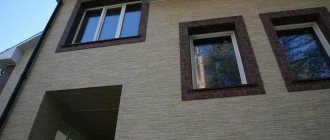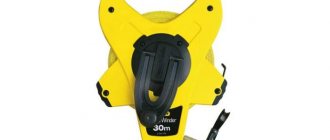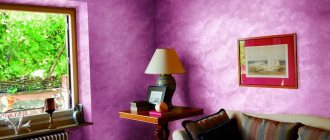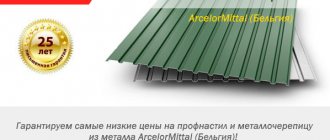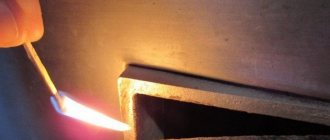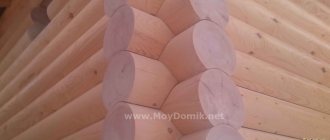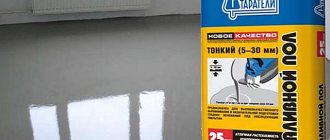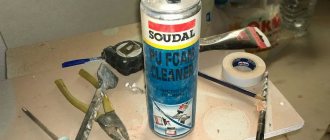What is metal tile
The roof covering material, metal tiles, is a thin metal sheet, the profile of which is made by cold rolling. This steel has higher strength than that produced by hot rolling. Aluminum and copper are added to the steel alloy, and the sheet is coated with layers of zinc and polymer. They reliably protect the sheet from corrosion, ensuring durability. The service life of metal tiles is up to 50 years.
How many sheets should there be in a row?
Here you need to divide the length of the slope by the width of the profile sheet. Data on the latter are indicated in the technical reference book, which is supplied directly with the metal tiles. Typically the width is 110 cm.
Suppose, with an 8-meter overhang length, a 1.1-meter sheet is taken. After division, it comes out to 7.27, and after rounding in favor of a larger number, it comes out to 8. As a result, one row welcomes 8 sheets.
Composition of metal tiles layer by layer
When choosing metal tiles, it is important to pay attention not only to the appearance of the coating, but also to the components of the material. The composition of metal tiles consists of layers that provide the necessary characteristics.
Steel. Cold-rolled profiled steel with a thickness of 0.35mm to 0.52mm is used.
Zinc. Metal tiles containing more zinc are much more durable than similar materials.
Priming. Additional protection of the main metal layer from corrosion is an additional layer of gray primer.
Passivation. An additional protective anti-corrosion layer is applied to the zinc coating.
Protective paint. Not used in all types. You can easily identify metal tiles with an additional coat of paint. Typically the paint is applied in the same color as the roof itself (as opposed to the gray color of the primer).
Polymer coating. Protects the roof from exposure to natural factors and mechanical damage. Further in the article we will briefly examine the main ones.
Color catalogs
Manufacturers of metal tiles usually use two tables with color schemes. The international one was compiled on the basis of the German catalog, which was developed at the Institute of Quality Assurance and Certification in 1927. The order was made by one of the manufacturers of paints and varnishes to make it easier to communicate with potential buyers. It was customary to use a numerical identifier to designate a particular color.
The first table consisted of 40 color solutions, which corresponded to the customer’s assortment. Today this development has become a world standard and is used by manufacturers of almost any materials that require coloring. Therefore, new colors are still appearing in the system, the number of which has already exceeded 3000 positions. The same applies to the color range of the assortment of finished metal tiles.
One of the catalogs of the RAL system Source ozlk.ru
The RAL palette today is presented in different versions:
- RAL Classic . There are 213 shades here. They are divided into 9 groups along the spectrum. It is considered a basic palette, so it is used more often than others.
- RAL Effect . It was developed in 2007. It includes 490 samples. Some of them are matte (suitable for water-soluble paints), others are glossy (suitable for metallic paints).
- RAL Desing . This catalog is in great demand among designers. It was developed in 1993. Here, 1825 shades are sorted according to three characteristics: hue, brightness and saturation.
- RAL Plastics . This highly specialized palette is designed for working with plastic products. It has 300 shades.
RAL Digital is a computer program that combines all existing tables from the system. The digital option is used by professionals among designers and planners. It is also used for programming tinting equipment.
Example of RAL 8017 color scheme Source bgsk.by
Types of metal tile coating
Sheet coating is divided into several types:
- Polyester. Metal tiles with this coating are economical. The protective layer has such advantages as flexibility and biostability. There are two types on sale: glossy and matte polyester with the addition of Teflon. The matte surface is more resistant to mechanical damage, temperature changes and ultraviolet rays. The matte surface is provided by coating of the brands Cloudy, Matt, Safari. The glossy surface of polymer-coated metal tiles is Unikma, Satin, Still Silk.
- Polyurethane. This type covers the material with a thick layer, which provides higher performance in terms of protection against corrosion and mechanical damage. Polyurethane coating is produced by names - Agneta, Prisma, Pural, Quarzit, Purman.
- Polyfluoride. It contains high-quality additives: acrylic and pigments that give different colors and shine. There is a polyfluoride coating with decorative chips, as well as an imitation of copper or shiny steel coating. Sheets have a smooth surface - Norman, Atlas, Velur.
- Plastisol. Very high quality material. Withstands both high and low temperatures without losing its qualities. The texture ensures color fastness. Structural and textured coatings are represented by brands - Viking, Drap, Velvet, Safari, Purex.
- Pural. The addition of polyamide creates a durable and hydrophobic protection. Distinguished by the following advantages: long service life, high resistance to mechanical damage and temperature changes, color fastness. The surface of metal tile sheets coated with pural is matte, very beautiful and velvety in appearance.
Acceptable fastener quality
Multi-layer profiled sheets of tiles with a steel base require reliable connection with proven fasteners.
Therefore, before you rejoice with slogans about covering the roof with metal tiles, you need to purchase a hundred or two special screws with rubber washers.
Special – made from hardened galvanized steel. Fastening technology is also of great importance:
- Firstly, the screws must be installed strictly perpendicular to the surface, i.e. no bending;
- Secondly, the tightness of the screw caps to the surface of the tiles should be maximum;
- Thirdly, the length of the screws must correspond to the thickness of the roofing material and sheathing so that the fasteners are deep and reliable.
The sheathing is a frame made of inch edged 24-25 mm boards. If the climate is harsh, then the lumber should already be 32 mm thick.
Even bars with a cross section of 50x50 mm are allowed. But they are mainly used between rafters.
The distance between the sheathing boards is equal to the step of the transverse wave of the metal tile. But this rule does not apply to the very edge of the structure - the hollow. Here, the pitch of the load-bearing wooden base is always 70 mm less than the pitch of the wave.
Also, not every photo of a metal tile roof demonstrates the installation of an additional strip under the sheathing in the overhang area. This is necessary to increase the resistance of the structure to loads and create a base for the drip.
Scope of application of metal sheet tiles
Sheet metal tiles are used mainly in private construction for finishing the roofs of houses, non-residential buildings and premises. The scope of application of sheets allows them to be used not only for their intended purpose. They are often used to construct fences that have a beautiful appearance.
Its use is limited to covering broken and domed roofs. Metal sheet shingles are not as flexible a material as soft roofing tiles. Therefore, when constructing such complex shapes, up to 50% of the material can go to the remainder. A flat roof also does not allow the use of metal tiles. Due to the low slope, precipitation will be retained on it, which will shorten its service life; it will begin to leak after 3-4 seasons.
The following types of roofs are suitable for installing sheet metal tiles:
Metal tiles are a good option for covering the roof of bathhouses, terraces, gazebos and canopies for recreation, and outbuildings.
Permissible roof slope for metal tiles
The material can be used for roofing with a slope of at least 14–15°. Otherwise, snow will linger on it and leaks will quickly form. Recommended temperature range from -50 to +50ºС. At higher and lower temperatures, the material begins to lose its characteristics faster.
When using metal tiles in regions with difficult weather conditions, it is necessary to follow special installation technologies and additional measures to protect and care for the roof.
Cold roofing pie
A waterproofing layer is spread along the rafter legs, which is pre-fixed using a construction stapler. Then the counter-lattice is stuffed. The sheathing boards are attached to it, then the metal goes on.
As in the case of a warm pie, in this case it is also necessary to ensure proper ventilation of the metal tile roof. It is achieved thanks to the counter-lattice, which provides a gap between the waterproofing film and the sheathing boards.
For the roofing pie under consideration, an additional vapor barrier layer is not required. The technology itself is used extremely rarely, since a roof without insulation produces large heat losses and does not cope well with noise. It is possible to insulate the ceiling, which serves as the ceiling in the house.
Advantages and disadvantages of metal tiles
The advantages of metal tiles have ensured that this material is in demand among consumers, including professional builders, architects and consumers. The advantages of metal tiles are:
The disadvantages do not reduce the above advantages, but they are definitely worth mentioning.
Warm roofing cake
The layers of the roofing pie must be arranged in strict sequence. The composition of a warm roof is represented by: a rafter system, a vapor barrier film, a thermal insulation layer, waterproofing, counter-lattice, sheathing and, finally, the metal tile itself.
Rafters and additional reinforcement of their load-bearing capacity make up the roof frame. The vapor barrier releases steam from the room; it is attached to the inside of the sheathing boards. Thermal insulation is placed between the rafters, for example, it can be mineral wool.
Waterproofing the roof under metal tiles is necessary to prevent the ingress of condensation that falls on the back side of the metal. The counter-lattice presses the waterproofing layer against the rafters and creates the necessary ventilation gap between the waterproofing and the sheathing. The sheathing boards are nailed to the counter-lattice, and metal tiles are attached to them using self-tapping screws.
Metal tiles: profile types
Metal roofing tiles come in several types. The basis for division into varieties is the types of sheet material and profile shape. Metal tiles are divided into three main types:
Monterrey. In this profile, the metal tile has a width of 1.19 m (useful 1.1 m) and a wave pitch of 0.35 m. The roof has a classic, attractive appearance. Profile height: 25+14mm. Supermonterrey. It differs from the previous model in the height of the profile, due to which this metal roof has the maximum resemblance to natural (ceramic) tiles. Profile height: 25+21mm. Maxi. The profile is almost identical to that of the Supermonterrey. The only difference is the longer wave pitch (0.4m).
Comparison with other materials
If we compare metal tiles with other roofing materials, a mixed picture emerges.
Compared to soft roll materials, it has limitations on the slope angle and worse thermal insulation and sound insulation properties. However, it is significantly superior to them in strength and durability.
Metal tiles are quite comparable in appearance to ceramic tiles, inferior in sound and heat insulation properties, but they are lighter in weight, easier to install, and cost less.
Compared to slate, it is distinguished by increased strength and aesthetics. At the same time, it will cost a little more.
Consumers, when choosing metal tiles, especially note the optimal ratio of appearance and durability to price.
Characteristics of metal tiles according to GOST
There are established requirements and characteristics according to GOST, which metal tiles must comply with. It is very important to check their suitability when purchasing.
Dimensions of metal tile sheets
The width of the metal tile sheet, depending on the profile height, ranges from 1.1 to 1.19 m. The higher the profile, the smaller the width. This is due to the typical size of a flat sheet (1.25 m), from which metal tiles are subsequently profiled.
Weight of metal tiles per 1 sq.m
The weight of sheet metal tiles affects the method of transportation and the degree of difficulty of installation. It also shows what load the total weight of all sheathing sheets gives. The norm for sheets of different thicknesses is regulated by GOST. According to the standard, weight is measured in kilograms per square meter. For thin-sheet metal tiles it is 4 kg, taking into account permissible deviations up or down. For thicker sheets (0.4–0.5 mm) per 1 sq. m has a load of 5 kg/m².
Thickness of metal tile sheets
An important parameter is thickness. Strength, resistance to mechanical loads and the ability to withstand heavy weight (for example, snow masses), while maintaining its shape and tightness, depend on it.
Particular care should be taken when choosing a metal roof in the central and northern regions, where the roof structure is often influenced by snow loads. The thickness parameters of metal tiles established according to GOST divide them into three types:
The northern and central regions of Russia and their climatic conditions require premium segment products to be installed on the roof. This will protect the roof from mechanical damage and the effects of atmospheric phenomena: snow, hail, icing.
Installation of the valley
The planks are fastened with an overlap of 20-40 cm. In this case, it is necessary to move from the cornice to the ridge. The end of the lower cornice strip is formed under the side. Near the ridge, a seal is made on the last strip.
Sheets of metal tiles suitable for the valley are cut approximately 7 cm from the axis of the laid plank. The valley itself is fixed with self-tapping screws, the cut edge of the metal tile is attached at the points of contact with the strip.
It is possible to decorate the edges of the cut metal tile sheet using special overlays. The latter are laid starting from the bottom of the roof, the overlap should be approximately 10 cm. The overlays prevent snow from blowing under the sheet cuts and make it easier for water to roll into the valley.
Warranty for metal tiles and their service life
The service life of metal tiles depends on the finishing coating of the profiled sheets and environmental factors. Plastisol coated sheets have the longest service life. 50 years is the actual warranty period from the manufacturer.
The second place in terms of durability is occupied by polyurethane coating and PVDF (vinyl-based substance). Their durability is measured at 30–40 years. Other types of coatings can last up to 30 years. However, the manufacturer only provides a 10-year warranty.
The service life is also affected by the selected types of profiles and the manufacturer’s compliance with GOST requirements for the characteristics of roofing materials. Metal tiles must meet these requirements, because a reliable roof covering is the most important component when building a house.
Tools
For work you will need: a screwdriver with a bat for a roofing screw, a cutting tool, a special strip to maintain the same distance between the sheathing, a tape measure, a tapping cord, a marker, sealant, and a hammer.
Professionals do not recommend using a grinder for cutting sheets, as it will burn the edges of the cut and may leave traces of hot scale on the surface. This will subsequently lead to metal corrosion.
